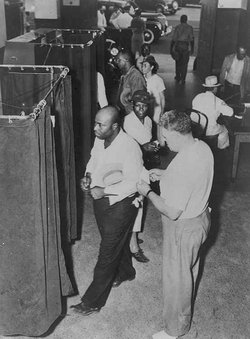Overall decline masked by effects of the South
i.e., increases in voting among African Americans in the South
as a result of the Voting Rights Act 1965

Voting
The most minimally
demanding
political act
However, discuss barriers
to
American voting
compared
to other established democracies
Only Switzerland
ranks
lower
Other political
activities
1970s Americans were twice
as likely as citizens of Britain, Germany, Austria, the Netherlands to
work on campaign
Discuss differences in political parties
1995 we ranked 20th out
of
40 democracies in terms of our likelihood of discussing politics with
our
friends
2002 OECD comparisons
Americans still
precocious
in associational activity
Compared to OECD average
We are 2.5 x more likely
to be members of
church associations (49%
compared to 18%)
And roughly 2 x more
likely
to be members of
art associations (21%
compared
to 12%)
political associations
(15%
compared to 8%)
We are at or slightly
above
in all associations except
unions (9% compared to 21%)
But has our political participation declined over time?
Putnam graphs voting in
presidential
elections on p. 32 Figure 1
Overall decline
masked
by effects of the South
i.e., increases in voting
among African Americans in the South
as a result of the Voting
Rights Act 1965

However, South begins
to
mirror national patterns by early 80s
Rates 1996 lowest in 164
years
Why?
Most common
explanations
are:
Growing distrust of
government
Declining party
mobilization
Fraying social bonds
Political dealignment (in
turn, based on transformations in economy, political identities,
partisan
identification, shifting regional interests)
Putnam suggests the
decline
is based on generational changes
“a generation gap
in civic engagement” (34)
Discuss intracohort vs. intercohort changes
Generational change =
intercohort
change
Putnam claims the decline is voting is “like a fever…a sign of deeper trouble in the body politic” (35)
Why??
Because voters tend to be the people who do a lot of other social capital generating activites like give to charities, volunteer, serve on juries, attend school board meetings, participate in public demonstrations, cooperate with other citizens on community affairs (35)
Thus, declining in
voting
an indication that these other activities likely in decline as well
Other related problems
Younger generations:
Know little more about
civics
than they did the 1940s despite completing more years of schooling
Are less interested in
public
affairs
Are less likely to
read newspapers daily
So decline not just a
function
of youth; today’s youth are less interested than the youth of the 1950s
and 60s (37)
Other
Electoral/Partisan
Political Activities (see Figure 4, p.41)
Number running for office
constant
Number working for parties
declining
Number attending political
rallies or speeches declining
Political organizations
strong,
more with paid professional staffs
(phone banks, paid
canvassers)
Less often with work of
rank-and-file
Fewer rank-and-file
(decline
in party ID, partisan voting)
Political participation more often in the form of money than time (40)
Communal Participation
(Figure
5, p. 43)
Number attending public
meeting down
Number serving as club
officers
down
Number serving on
committees
down
Number members of better
gov’t groups flat
Public Expression
(Figure
6, p. 44)
Number signing petitions,
writing congress reps, senators down
Number writing letters to
newspapers, making speeches, writing for magazine or newspaper down/flat
Summary of Communal
Activities
The number utterly
uninvolved
in these increased by a third over the 70s and 80s
By 1994, most Americans
did not engage in any (44) (i.e., 64% p. 46)
See Table 1 for trends in political and community participation
Increased alienation,
distrust
in politics
April 1966 66% of
Americans
rejected: “the people running the country don’t really care what
happens
to you”
December 1997 57% accepted this view
Compare relative state
of
country at each time